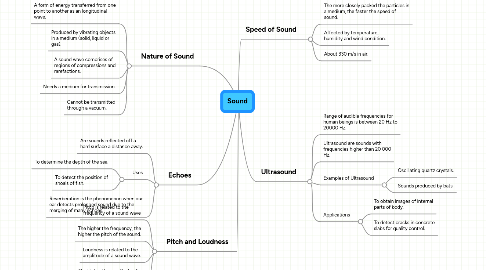Sound
by Kuek Zheng Wei


1. Nature of Sound
1.1. A form of energy transferred from one point to another as an longitudinal wave.
1.2. Produced by vibrating objects in a medium (solid, liquid or gas).
1.3. A sound wave comprises of regions of compressions and rarefactions.
1.4. Needs a medium for transmission.
1.5. Cannot be transmitted through a vacuum.
2. Pitch and Loudness
2.1. Pitch is related to the frequency of a sound wave
2.2. The higher the frequency, the higher the pitch of the sound.
2.3. Loudness is related to the amplitude of a sound wave.
2.4. The higher the amplitude of a sound wave, the louder it is.
3. Echoes
3.1. Are sounds reflected off a hard surface a distance away.
3.2. Uses
3.2.1. To determine the depth of the sea.
3.2.2. To detect the position of shoals of fish.
3.3. Reverberation is the phenomenon when our ear detects prolonged sound due to the merging of many echoes.
4. Speed of Sound
4.1. The more closely packed the particles in a medium, the faster the speed of sound.
4.2. Affected by temperature, humidity and wind condition.
4.3. About 330 m/s in air.
5. Ultrasound
5.1. Range of audible frequencies for human beings is between 20 Hz to 20000 Hz.
5.2. Ultrasound are sounds with frequencies higher than 20 000 Hz.
5.3. Examples of Ultrasound
5.3.1. Oscillating quartz crystals.
5.3.2. Sounds produced by bats.
5.4. Applications
5.4.1. To obtain images of internal parts of body.
5.4.2. To detect cracks in concrete slabs for quality control.
